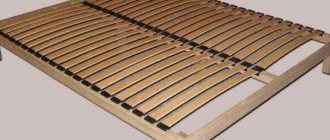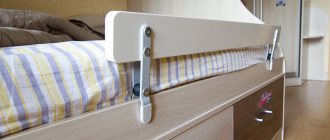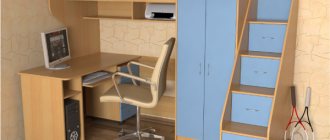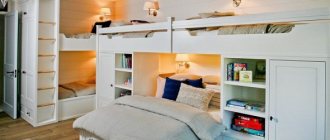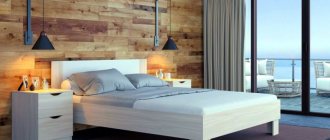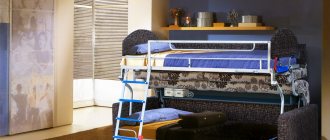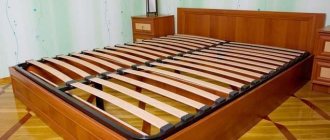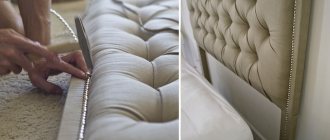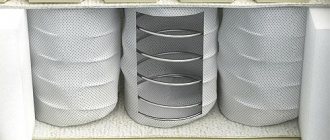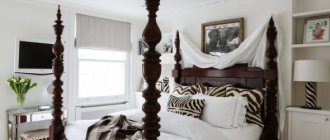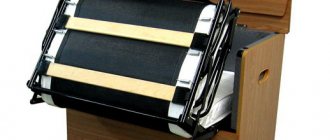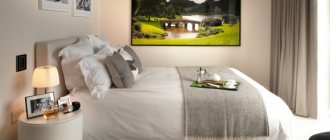Classification of main types of beds
The models of functional beds on sale for bedridden patients, disabled people and the elderly differ in their design and functionality. A wide range of possible options ensured their use in intensive care wards, hospital departments of various types, rehabilitation centers, and social institutions. The functional medical bed is easy to use and manage. Some of its varieties are additionally equipped with a folding mechanism, which facilitates dismantling, transportation and storage of the product.
Number of sections
The main criterion by which functional beds are classified is the number of moving elements - sections in the structure. There are two-, three- and four-section models with a certain level of comfort and versatility. You can change the position of the patient’s body on the smart bed by setting a certain angle of inclination of one or more segments.
A two-piece model with a moving headboard will elevate your head, shoulders and body. This position is necessary while eating, reading, watching TV. In addition, a semi-sitting position helps normalize blood circulation in the cervical spine.
For bedridden, sedentary patients with problems in the musculoskeletal system, a functional three-section bed is more suitable. The movable leg part will not allow a bedridden person to slide down, causing bedsores and back pain. Changing the position of both the head and legs is important for injuries to the lower extremities and chest. The anatomically correct position of the patient can remove tension in the abdominal cavity, reduce congestion in the lungs and blood vessels, and relieve tension from the spine.
In the center of the bed of the four-section functional model there are intermediate compartments. They have a fixed or adjustable position, ensuring comfort in the lumbar and pelvic areas. A distinctive feature of this type of bed is the ability to transform into a comfortable chair, which increases the mobility of patients with minor injuries during the period of rehabilitation or postoperative recovery.
Adjustment method
Movable structural elements are driven manually or electrically.
The functional mechanical bed is equipped with sliding stops (like a folding bed), a hydraulic drive with a pneumatic spring, or is controlled by levers.
All of the listed mechanisms are driven manually. The handles of the screw levers are located in the foot part under the stock, so as not to take up additional space in the room and not to restrict the freedom of movement of service personnel.
A functional electric bed is an expensive product, but the high price is fully justified by the capabilities that this type of furniture provides. First of all, this is the patient’s relative independence from family and medical staff, which has a positive effect on his emotional state.
Motorized models are controlled by pressing a button on the control panel in the bed frame or on a portable remote control. By raising, turning and lowering one or several sections at once, you can optimally adjust the surface of the bed relief to the patient’s position. The control panel has a function to lock some keys to disable unnecessary options. If there is a need to fix the patient’s position, the remote control can be blocked completely.
A functional electric bed acquires additional options thanks to the ability to adjust the height of the bed and the reliable mechanism of wheels on the legs. Self-orienting wheels are equipped with individual brakes and rotation angle locking, which allows the bed to move easily and silently, installing it anywhere.
Important! When purchasing a bed model with an electric drive, you should inquire about the possibility of mechanical adjustment in the event of a power outage. This becomes especially relevant when it becomes necessary to return the stock from a fixed option to its original position.
Additional devices and accessories
First of all, it is worth noting the provision of medical functional beds with side rails, which are conventionally divided into three types:
- Solid aluminum crossbars with cross bars are most common.
- Plastic curtains with which you can gain access to any part of the torso and limbs.
- The wooden crossbar is made from environmentally friendly materials.
The backrests of medical multifunctional beds are either fixed or removable. The second type is considered more convenient.
Among models with electric drive, couches equipped with a special battery are popular. Autonomy from the network allows you to operate the bed even when the lights are turned off.
Depending on the severity of the patient’s well-being, the functional medical bed is equipped with other accessories and devices. The most common elements are:
- arc for pulling up;
- sanitary facilities;
- hooks for drainage containers;
- support rods;
- fastenings for an infusion stand (tripod for a dropper);
- protective bumpers at the corners of the bed;
- right and left leg sections.
Both wooden and metal beds are often equipped with an anti-decubitus mattress, folding handrails and orthopedic accessories.
Additional elements and material type of functional beds
Manufacturers of medical equipment are constantly improving their products, supplementing them with elements that are designed to maximize the comfort and safety of a bedridden patient. In the case of functional beds, these are:
- adjustable side and end handrails (removable and stationary);
- over-bed trapezoid (gander holder);
- drip stand;
- toilet device;
- hooks for additional accessories;
- bedside table;
- sectional mattress.
Built-in devices in modern models automatically determine the patient’s body weight, the angle of the section, and use an adjustable timer to turn the patient over at night.
A functional bed with accessories is made of metal (steel, aluminum), plastic and wood. Sometimes these materials are combined to give the product strength, lightness and an aesthetic, homely look. The frame is a durable mesh made of metal profiles or wooden planks. Flexible wooden slats provide the necessary rigidity in the lumbar region and create an orthopedic effect.
The metal parts of the blood are coated with a special powder paint with an antibacterial composition, which allows it to be washed with any disinfectants. The coating of the remaining elements has water-repellent properties and is resistant to mechanical stress and ultraviolet radiation.
A children's functional bed excludes the presence of parts that can harm the baby's health. The backrests and railings are securely fixed and must have protective bumpers to protect against injury.
Attention! Additional elements (side rails, mattress) may not be included in the factory package of a functional bed. It is advisable to discuss this point with the seller in advance.
Functional bed Armed, technical characteristics of the model with electric drive:
| Parameter | Index |
| Bed size (LxW) cm | 218x95 |
| Stock size | 195x89 |
| Bed height | 47-87 |
| Number of sections | 2-4 |
| Angle of inclination of the back section (degrees) | 0-60 |
| Angle of inclination of the hip section | 0-40 |
| Angle of the ankle section | 0-20 |
| Maximum load (kg) | 250 |
| Product weight, net (kg) | 69,5 |
These are standard indicators that give an idea of the properties of functional medical beds. Models from other manufacturers (Burmeier, DHC, OSD) can withstand larger loads (up to 300 kg), have larger or smaller bed sizes and demonstrate a wide range of section rotation angles. The final price of the product depends on the complexity and completeness of the design.
Three-section medical functional bed KFZ-01-MSK
Designed
for the implementation of hospital and functional care for patients in all departments of hospitals of medical institutions. Screw adjustments of the sections' inclinations create more comfortable conditions for placing patients on the bed and facilitate the work of medical personnel. Backrests made of durable plastic with an ergonomic (atraumatic) shape and a wide selection of additional equipment provide conditions for greater operational safety of the bed, and also create additional opportunities for providing qualified assistance and higher quality patient care.
Frame
The bed bases and frames are welded from steel pipes and profiles.
Legs
– made of steel pipes, attached to the frame using bolted connections.
Multi-section
The bed is made of steel pipes and perforated panels made of steel sheet with a thickness of 0.8 mm and ensures a comfortable position for the patient on the bed and free ventilation of the space under the mattress.
The plastic backrests
are quick-release (pair), made of rigid polyethylene, have an ergonomic shape with rounded atraumatic edges and corners, and
are reinforced
with metal pipes for greater strength. Installed in mounting slots on the bed frame. The backrests are equipped with roller corner protective bumpers made of plastic.
The material of the backrests is light and durable, does not change color, and is resistant to both bactericidal irradiation and regular treatment with all types of medical disinfectant and cleaning solutions.
All metal
parts of the bed are coated with environmentally friendly epoxy polymer powder paint, which is also resistant to regular treatment with all types of medical disinfectant and cleaning solutions.
wheels
are rotating, self-orienting, ∅100 mm, equipped with a reliable steel fork with a precision angular contact bearing, a polypropylene rim and a tire made of gray polyurethane, which does not leave marks on the floor, and
two wheels
with an individual braking device
Tilts
The bed sections are infinitely adjustable using screw mechanisms.
Back section
equipped with an ergo-lift function, which allows the section to be tilted up to 85°.
Foot section position
regulated discretely using a pair of Rastomat mechanisms. Rostomat mechanisms allow for stepwise lifting with unlocking in the upper position and subsequent lowering to zero angle of inclination.
Adjustment of section angles:
- dorsal - from 0° to 85° stepless, with a screw mechanism - femoral - from 0° to 45° stepless, with a screw mechanism - foot - from 0° to 20° with Rostomat mechanisms
Screw mechanisms
controlled by rotating the handles located under the foot backrest. The handles are foldable and can be stowed under the bed frame if necessary.
Valid distributed
dynamic load – no more than 200 kg.
Weight
beds – no more than 66 kg.
Completed
additional equipment and accessories.
Delivered
in disassembled form.
A guide to choosing a functional bed
When thinking about purchasing a product, it is important to maintain a reasonable balance between the functionality of a particular model and the practical need for it for the patient’s needs. A patient in a coma does not need a complex, expensive structure that turns into a chair. At the same time, for a conscious person who has retained the mobility of the upper body, using a functional bed with a remote control allows him to maintain relative independence.
Manufacturers and sellers are advised to make their choice based on the following factors:
- diagnosis, age, weight of the patient;
- duration of stay in a supine position;
- physical characteristics of the person caring for the patient;
- room dimensions and interior requirements;
- solvency.
This approach will help you not to overpay for options that are not needed during operation and not to skimp on functions that are vital for the patient. If this type of medical furniture is required for a short period, you can consider renting.
A positive attitude is halfway to defeating the disease and a speedy recovery. A comfortable, functional bed reduces the risk of complications and unpleasant consequences that can result from a person’s prolonged stay in a lying position. They improve both the physical and psychological well-being of patients and the people who care for them.
